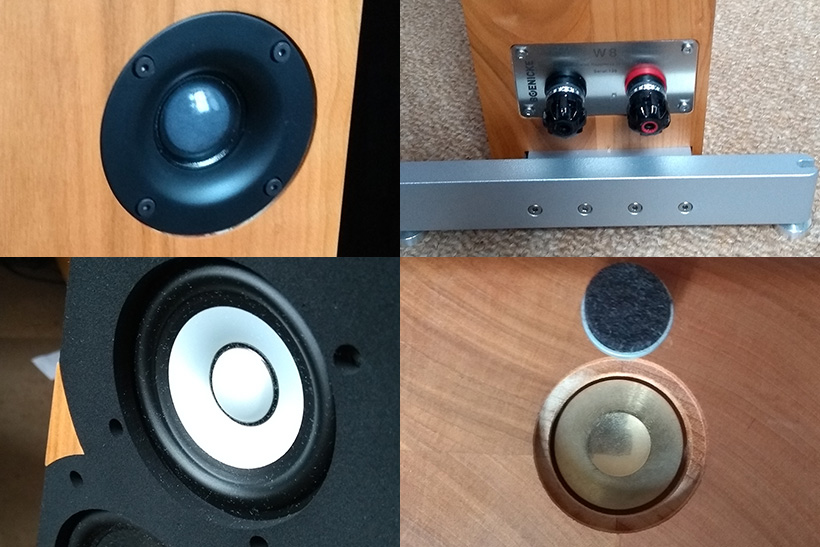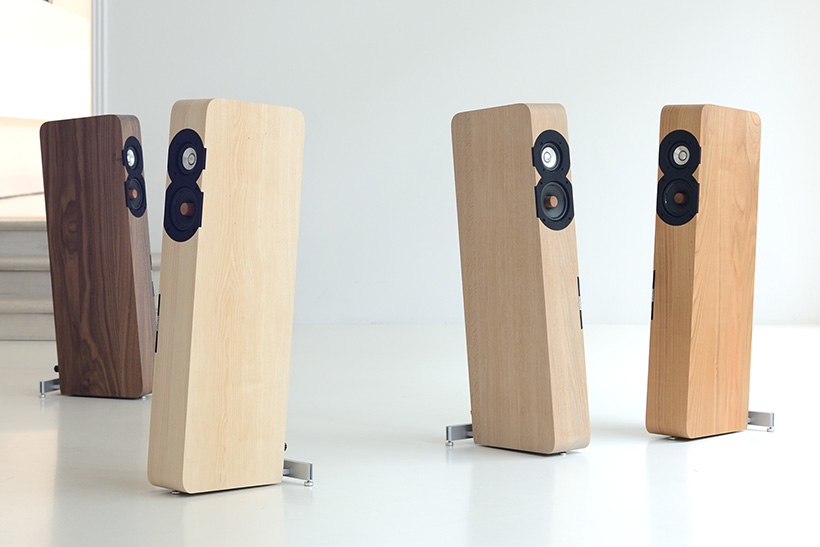The problem with Sven Boenicke is he always plays good (see: my kind of) music at the Munich High End show. When you have heard to same old tunes in a dozen rooms it’s a breath of fresh air to come across a space where they have contemporary music that’s relaxed and untainted by audiophilia. This is at least partly why his systems always seem to sound good, that fact that they are usually combined with electronics from CAD is also highly beneficial even though that company only makes the 1543 DAC and Ground Control devices. This year saw the unveiling of Boenicke’s first amplifier, which looks great as you would expect.
The theme with this and to a greater extent the loudspeakers is the use of solid wood. The labyrinthine cabinet for the W8 is machined out of the stuff to create internal partitions and conduits that are far more elaborate and complex than can be achieved with an assembled construction. In the W8 you can see separate chambers for the main tweeter and the midrange, which completely cut them off from air pressure created by side firing bass units. It’s an extraordinary and expensive way to build a loudspeaker cabinet but undoubtedly contributes to the sound they produce.

The drive units are unusual as well, there are two tweeters, a fairly conventional dome facing backwards dubbed the ambient tweeter and a wideband metal cone on the front. The latter is similar to a Jordan driver with a three inch cone and the capacity to go much lower in frequency than a dome, Boenicke does not however tell you where the crossover point is, just that the filter is a first order type with an “electromechanical parallel resonator” installed. Midband is proved by a four inch paper cone with only a first order low pass filter and no restrictions on upward extension. It has an apple wood phase plug and a maple cone attached to the magnet, which must add a resonance of its own. Bass is delivered by a six and a half inch long throw driver with no crossover.
This minimal approach to crossover design makes it easier to integrate the drivers but means that large parts of the audio band are produced by more than one driver, which will have its pros and cons. In a world where anything above a two-way often has a fourth order crossover it’s almost as unusual as the cabinet construction. Even the way that the box is supported is different, the main stabilising influence over what is quite a narrow cabinet for its height is a bar with two adjustable feet that slots into the back of the speaker with no fixing. Essentially a metal tongue sits in a narrow but far from tight slot to provide two points of support at the back while a third foot screws in at the front. On the SE version of the W8 a ball and cup arrangement interfaces with a brass cup built into the base to provide support at the front while a pair of damped spring legs slot into the back of the box. These would provide a good degree of isolation albeit not as much as a fully sprung support.

Build and finish are exemplary on the W8, attention to detail is as high as you would expect of a Swiss product. The way that the damping rings around the drivers are so precisely matched to the woodwork is particularly pleasing and contributes to making this is a very attractive compact floorstander. Its real wood construction and curved corners make for a piece of furniture that undoubtedly appeals to a broader market than that for serious hi-fi.
Sound quality
What initially strikes you about the W8 is the solidity of bass it produces, this I suspect is related to the machined wood construction creating a very stiff enclosure. It really is the sort of bass you expect of a larger speaker. The mids and highs are smooth and relaxed, it’s a the sort of balance that would work in a contemporary room setting with minimal soft furnishings and is perhaps a little laid back for my relatively well damped space.
In terms of dynamics and imaging the W8 is not the most outgoing of speakers, that wideband driver probably doesn’t extend as high as a conventional tweeter and image height suffers as a result. But again in a more reflective room that would probably be made up for, especially if you wound up the volume. Crucially this speaker times well, I can forgive any audio component some shortcomings as long as it gets the timing right and happily this Boenicke does. Combine this with the control and extension in the bass and you have a speaker that’s very easy to enjoy, but you do need a decent amplifier to achieve this. The specs give an unusually vague sensitivity rating of “84 – 88dB depending on frequency” and this combined with a four Ohm impedance would explain why I had to turn the system up higher than usual. Most listening was done with the beefy ATC P1 150 Watt power amp but I also tried a 20 Watt, class A monoblock from British brand CAAS and that resulted in a very lovely sound indeed with Nils Frahm and Olafur Arnalds’ A Winged Victory for the Sullen.

I later discussed these points with CAD and Nic Poulsen of Trilogy Audio who has also shared a room at High End with Boenicke in the past. They explained that the W8 is a very current hungry loudspeaker but not one that works well with amps that have a lot of grip like the ATC P1. They were also both of the opinion that the W8 is a very fine loudspeaker indeed when you assemble the right system around it. Not the most tonally accurate but easily one of the most enjoyable they had spent time with.
I would have liked to spend longer with this speaker but circumstances (family holidays) prevailed against me and I wasn’t able to extend the listening. Overall the Boenicke W8 is a relaxed and, so long as you have the amplification, effortless loudspeaker for musical explorations and background vibes. It’s not the most analytical or revealing speaker at the price but when you combine the style and execution of its construction, the depth of bass for the size and the quality of timing you can see that it warrants the asking price. Even more so if you have a modern home and want a speaker that will look very good in the space.


